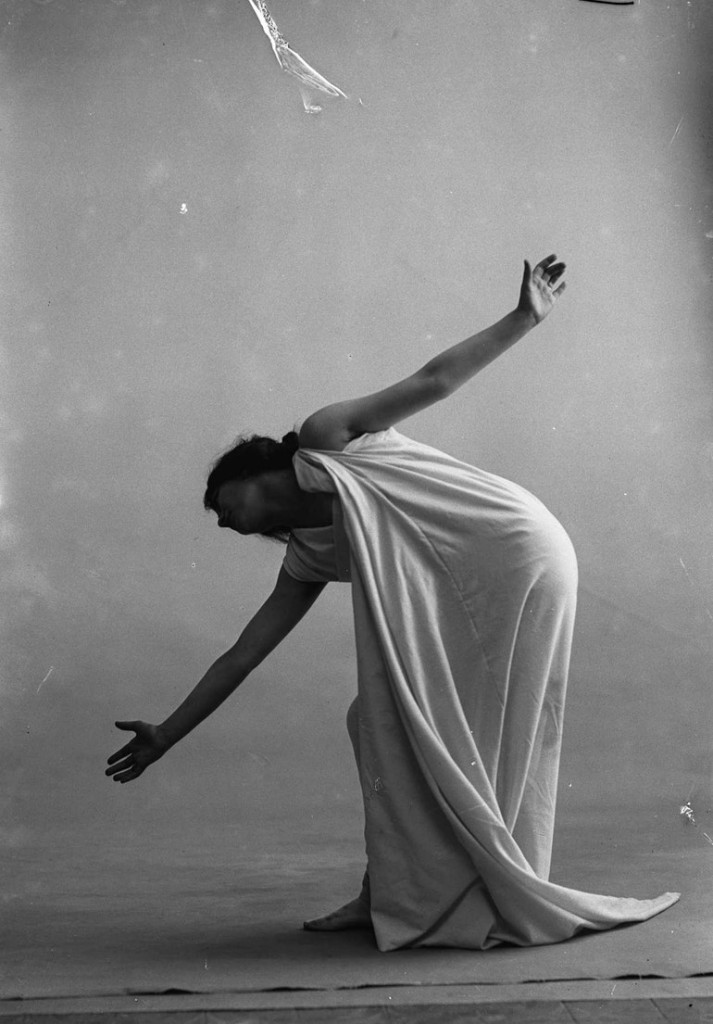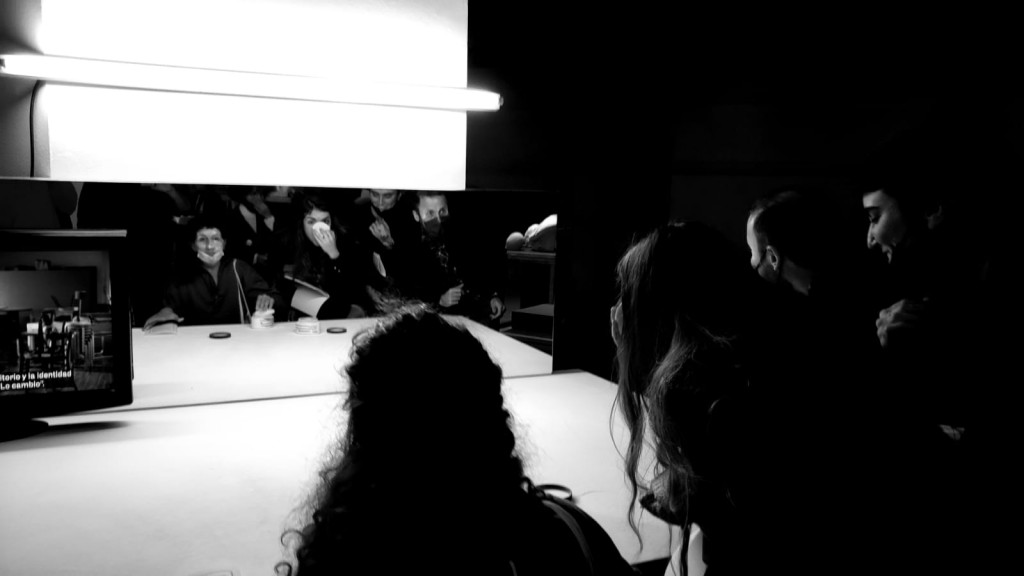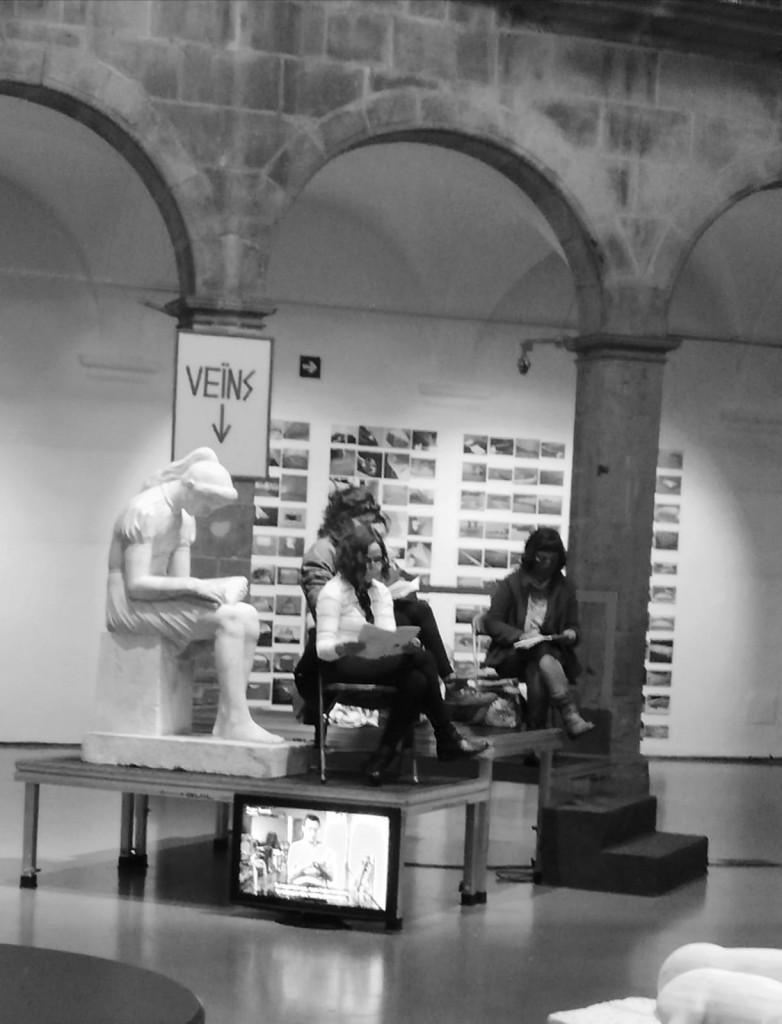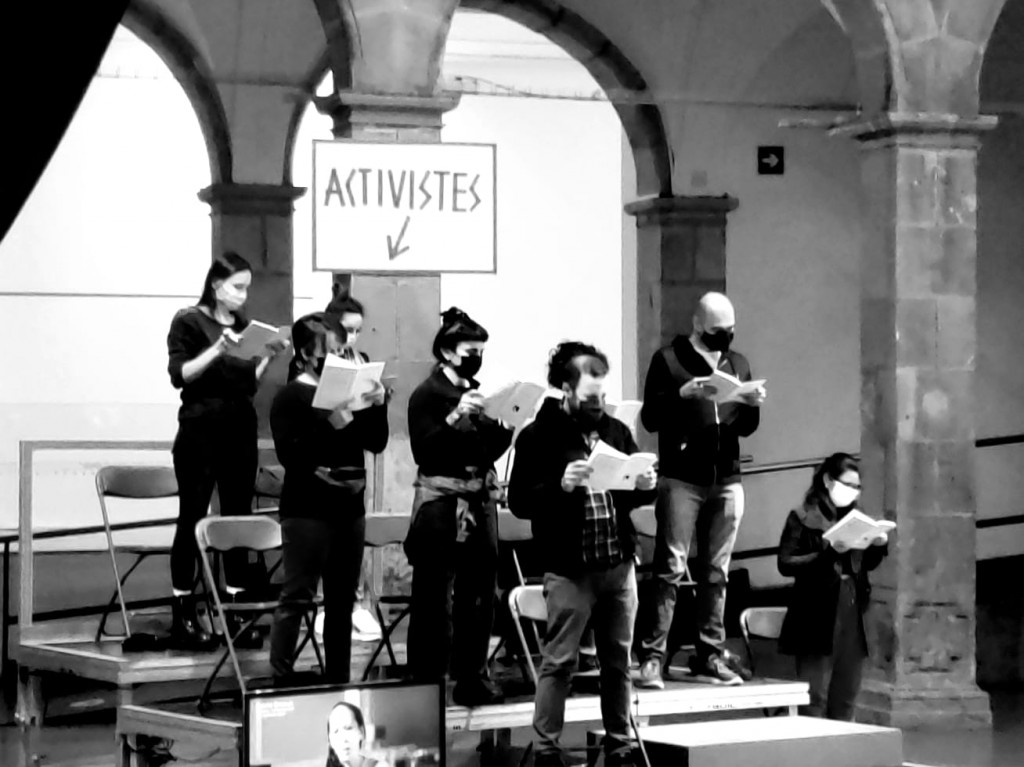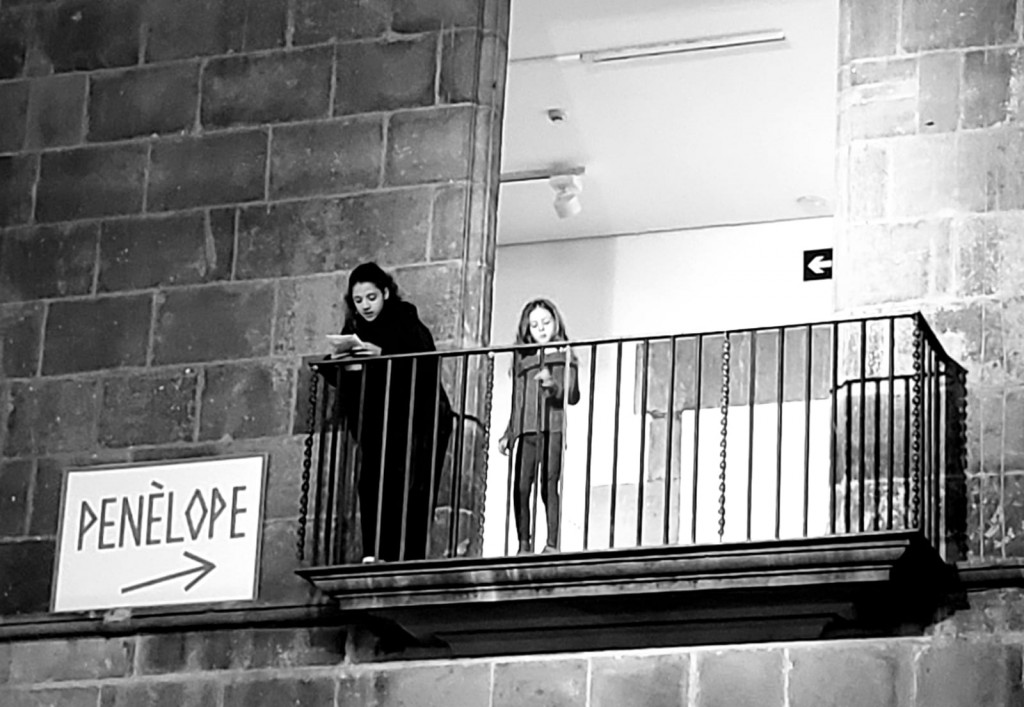Desnonissea is a commission by Enric Puig, the new director of the Arts Santa Mònica in Barcelona that can be seen between September 23 and the beginning of January 2022.
Here is the description of the piece at the beginning of August:
1) At the entrance of the cloister of the Centre d’Art Santa Mònica, there is a dressing room where the public is invited to paint their faces and hands with white. In another table, there are copies of the dramatic poem to be performed, by Núria Martínez-Vernis and Oriol Sauleda.
2) In the cloister there are different pedestals that are also staged at different levels. On top of each of these, there are sculptures of classical inspiration and natural size representing: a beast carrying in its teeth the corpse of a human being, a Venus stretched on a cushion, a mother protecting a newborn baby, and a gladiator.
3) Among the sculptures there are also televisions, where people such as Walter San Joaquín, president of the Republic of Human Statues of La Rambla, explain how to represent the different characters from their particular fields of knowledge.
4) In addition to sculptures, stages, and videos, behind each stage there is a sign indicating which characters should use each stage. The audience accompanies the sculptures on the different pedestals and represents the drama as if they were human statues.
The audience that comes to represent the drama can do so after having seen the exhibition, after having downloaded the text from the museum’s website, or without any preparation at all.
A DÉTOURNEMENT FOR THE DESNONAMENT OF THE DESNONISSEA. By Pedro Bennaton and Luana Raiter (ERRO Grupo)
The question that has been ringing since May 2021 “how to represent an eviction?” is the great problem and challenge of the Desnonissea (Roger Bernat and ERRO Grupo). Desnonissea is a spin-off of the final scene (or bonus track) of No hay citas disponibles. (ERRO, 2020), a piece that, as Manuel Delgado said, worked like a Swedish film: although it had an expected and desired to end, it ended in suspension. Now the final scene gains a life of its own by the impulse of a Dungeon Master of contemporary theater. A director who, with dozens of simple and ultra-complex devices at the same time, manages to get the audience to do theater.
In one of the performances of No hay citas disponibles, a person passing by on the street during the last scene requested a role in the eviction that was about to be staged. That person was designated to play the tenant’s lawyer. The other participants, who had seen the whole performance and understood that there was nothing to play because the show was over, left the spontaneous spectator unable to play his role. Frustrated, he questioned us about this abrupt end precisely at the moment when he had arrived and thought things would start, complaining about not being able to play the role that had been assigned to him. Roger Bernat, who was at the premiere of the play, thought the same thing and suggested that we take the last scene further and create a “family constellation” of the eviction. However, ERRO had already decided to represent the tragedy by suspending it and ending the show. Delivering the different roles involved in an eviction and, at that precise moment, abandoning the audience to their fate. Since the piece was about immigration and bureaucracy, the eviction could only be a bonus track or announcement of a new chapter of the drama represented.
That last scene of No hay citas… was created from the article “Anatomía de un Desahucio” (Anatomy of an Eviction), published in the Revista Masala in June 2020. When we read it, we jokingly imagined that it was the instructions to perform a Roger Bernat’s play. The cartography described by the Masala team, with illustrations by @biksakura, invites us to play – or at least to observe the eviction – with a more trained eye, or better, it trains us to participate in the situation with a very particular and inciting pedagogy. A few months later, the joke was revealed to be full of truth, like all jokes. Roger Bernat proposes us to give think further about the possibilities of that situation, for the exhibition at the Arts Santa Monica. One of the best things that ever happened to ERRO is that someone took a provocation seriously and tried to turn it into a new work. Bernat challenges us and challenges himself to think about how to represent an eviction. First, he proposes ethnographic research with the people who have important roles in the evictions, and later he initiates together with Núria Martínez-Vernis and Oriol Sauleda the writing of a dramatic poem that leads the participants on the way to represent the tragedy.
Theaters go on vacations, museums too, but the eviction never ends in this city. As the spectacle of social drama, eviction is a constant. It is the most repeated spectacle one can experience here. Even in suburban towns like Vilafranca, l’Hospitalet, or Sant Celoni, there are evictions every day. The eviction is a drama that never ends. A performance in looping that moves from one street to another, from one apartment to another, from one homeless person to another. Each new eviction connects with the next and comes from the previous one. Evictions involve the whole city. We imagine that eviction is over when a neighbor is thrown into the street, or when a neighbor commits suicide, or when people manage to stop it. Nevertheless, eviction is what we experience every day in the city. A continuous eviction that crosses all evictions.
Arts Santa Monica is a museum, not a theater (although nowadays theaters increasingly resemble museums and museums resemble theaters). In this museum located on La Rambla, just in front of the human statues and the monuments to Theater and Columbus, the possibility of representing an eviction is proposed, and to do so, give the audience the tools to become actors of this Homeric journey. The audience is invited to embody the statues and, with simple poses, evoke the dramaturgical potential of stillness. Transferring the poetics of the statues at the museum’s doors to the interior of the museum and showing on the visitors’ bodies the traces of a drama, that of eviction, which is a performance that we have all been learning for a long time.
However, how to educate the public, how to update what the visitor already knows and turn it into a drama of statues, a drama of living statues? Rebecca Schneider reminds us in Performance Remains (2001) that statues are the longest-lasting performance. The monuments to Columbus in the public squares of Spanish and Latin American cities eternalize the performance of colonization. Humanity is made of a constant displacement from the invasion of those who have more power in the spaces of those who have less.
The statue is the continuation of the performance of the historical fact that remains in the present. An eternal performance that acts in our daily life. The “apartment available” sign is an eviction that is happening, even if it seems to be over. Schneider’s point is not only that statues continue the political and social performances of the past, but that they project them into the future and act in the present. A statue shows a gesture that goes beyond the instant represented: it also shows the position in which it was before and towards which it is heading afterward.
How are the statues positioned in the Desnonissea? Augusto Boal, in his Theater of the Oppressed (1973), proposes as one of the categories of his theater, the Image Theater. This type of social theater is made for people to transform into static images the situations of oppression to which they are subjected. In a very slow rhythm, the participants of Image Theater create key images of their past, present, and future.
Today, even a tourist would be able to show Image Theater of an eviction. The images of the desnonament have become as recognizable postcards of the city as those that were stamped with the Barcelona Brand logo.
However, Image Theater is one of the least practiced categories of Theater of the Oppressed. The Forum Theater, for example, has much more diffusion, to the point that the Image Theater is sometimes considered a warm-up for the Forum Theater. Although in social networks, we practice a daily Image Theater based on selfies and likes on the selfies of others, in a perpetual static representation of our daily life.
Desnonissea gives the necessary tools to give autonomy to the museum visitor so that he can represent the epic poem, the contemporary tragedy, the cruel postcard of Barcelona that, however, is a drama that comes from ancient times and is projected, like the statues, in the future. Specialists in stage direction, declamation, mime, and Image Theater, but also people who have lived in first person the drama of eviction, help direct the public to this action that, definitely, we have been learning for centuries. Spain owes its wealth to the eviction of colonization. The capitalist system is a mechanism that works precisely thanks to the eviction of populations that are exterminated or forced to migrate. Desnonissea is the staging of this system.
(To be continued)
TEAM:
Roger Bernat with the collaboration of Erro Grupo (Luana Raiter and Pedro Bennaton). Epic poem by Núria Martínez-Vernis and Oriol Sauleda. Testimonies and indications by Walter San Joaquín (mime and living statue), among others. Systems: Mar Canet. Make up: Anita Sabina Vergara. Production: Arts Santa Mònica, with the collaboration of the Ajuntament de Barcelona.
Photo 1: Magdeleine G. dancing under hypnosis: “Le chien était blotti…” (Verlaine). (Verlaine). Photo 2: Magdeleine G. dancing under hypnosis: The death of Isolde. François Frédéric named Fred Boissonnas. 1902-1904. Geneva Library. Illustration: @biksakura, Masala Magazine no. 80, juny 2020.
